Companies will evolve to bring their products in a beautiful software experience. Read what has been presented at the General Sessions at DockerCon Copenhagen on October 17th 2017.
Steve Singh (Docker CEO) opened the European Conference 2017 by thanking the 10 million members of Docker Community and telling them “Hygge” that means “to be together” in danish.
He stated "The Foundation is not a Container, is a platform", and he continued introducing the theme of "change", that is a constant in technology. And now it’s up to distributed application in a distributed environment.
He mentioned then some examples, like NCR, that today is the leader in ATMs, and that, when world went digital, started to think “multichannel”. Today they define themselves as a “software company”. The same we can say for cars manufacturing like Tesla. The role of IT is changing radically and IT organizations has a strategical role. They have to delivery incredible software and incredible customer experiences.
The Enterprise Software supply chain integrates all this experience and allows you to build software faster and better.
Docker announced then some results reached:
- 21M Docker Hosts
- 24Billions Container Downloaded
- 77% growth in Docker job listing
Container Platform enables the software supply chain with:
- Diverse applications
- Disparate infrastructure
- Lifecycle management
- Orchestrate Complex Systems
- Secure by default
- Edge/IoT
- Serverless Anywhere
How to help customer to drive them in the new Digital Era?
Simply with MTA: Modernize Traditional Applications.
Docker is the solution upon you can run and manage all your applications and infrastructure.
It's about "modernize traditional applications" and building next gen applications. With Docker you can manage all in an integrated and portable way.
The container journey starts with the apps you already have. Without recoding. Without refactoring. By using the Docker Converter is easier and faster to do than typing ….
Portability, Agility and Security with 50% of total cost savings
Jeff Murr (Director Engineer for Container and Platform) presented then his use case at MetLife.
He first highlighted some numbers about his company: 100 million customers, 500$ Billion total assets, 63$ Billion revenue.
He started stating that innovation means always costs, risks, bets, but it requires to be brave.
He then described the main points of the MTA PoC implemented at MetLife:
- 1 App
- 1 Day time to containerize
- 70% less VMs; 67% less cores, 10x average CPU Utilization = 66% cost reduction
- cloned on 593 applications (10% of the total portfolio), this means repeatable experience
For him the Pattern for success is the following:
1 – Scope: start small and then grow
2 – Assess: select the right app candidate
3 – Team: create a strategy team
4 – Leverage existing operations
5 – Stabilize and innovate in smaller cycles
They were able to optimize infrastructure with Docker and on this solution, they created a globally Engineered Ecosystem.
Docker Enterprise Edition Creates a self-funding model to fuel change and innovation at scale.
With MTA you can manage image, automate policy, secure end-to-end (by signing, scanning, secrets), have enterprise multi-tenancy.
Solomon Hykes (CTO and Docker Founder) came then finally on the stage to talk about the future they are building.
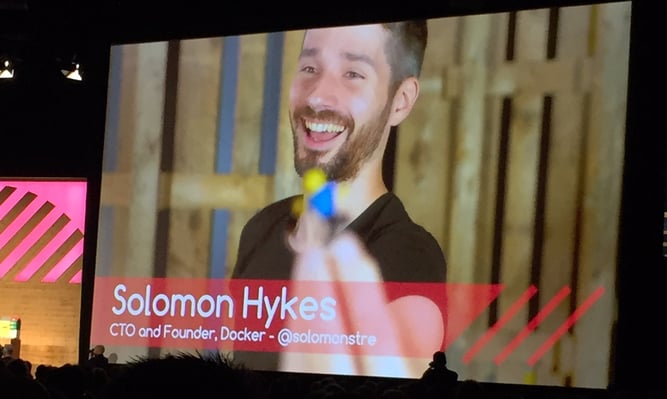
The Docker Platform is a Nutshell based on the following principles:
1 – Independence
2 – Openness
3 – Simplicity
The first level is the Container Runtime (containerd)
On top there is the Orchestration (Swarm)
Then you need Developer Tools (Docker Community Edition)
When you want to go to production you need Management Services (Docker Enterprise Edition).
Docker Improvement Process:
1 – Constructive
2 – Platform Improvement
3 – Repeat forever
He then made the most important announcement of the Conference: since not everyone is using Swarm, Docker will be delivering seamless integration with Kubernetes, the open source tool developed by Google, into the Docker platform. GA Q1 2018.
Bringing Kubernetes to Docker Enterprise Edition (EE) will simplify and advance the management of Kubernetes for enterprise IT and deliver the advanced capabilities of Docker EE, including security and management, to a broader set of applications.
Moby Project and Kubernetes, the two largest open source container projects, now collaborate at full speed!
Before today’s announcement, while it was possible to use Kubernetes with Docker, this was not an easy process. With the new Kubernetes support, it should be simpler for both Docker Enterprise Edition and Docker Developer Edition users.
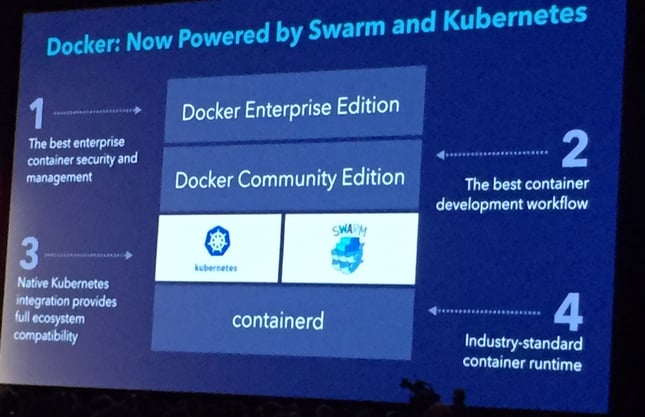
Solomon showed before the new Docker Community Edition structure:
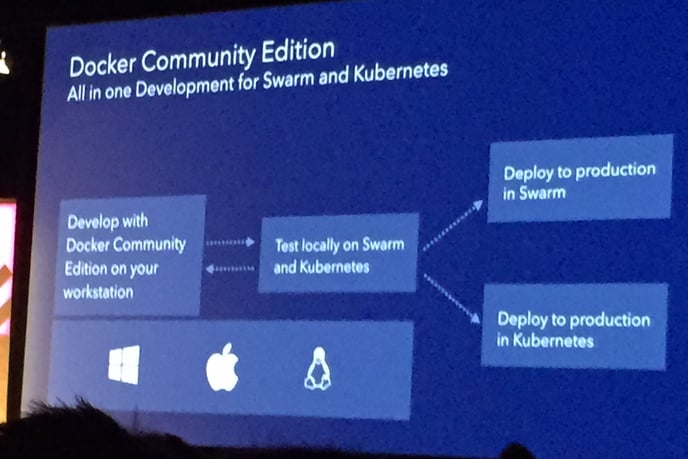
Then Solomon talked about the Docker Enterprise Edition and the management for swarm and Kubernetes. He analyzed the Swarm support and the Kubernetes support and features. Docker EE has a modular architecture that is designed to support multiple orchestrators. The Linux nodes are both Swarm and Kubernetes-ready and application teams can decide which orchestrator they prefer to use for the applications deployment.
You can find more details in the pictures below:
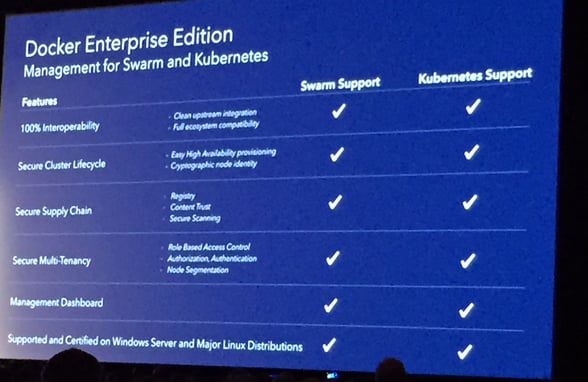
On Day 2 the Docker COO Scott Johnston lead the General Session.
He continued the issue introduced the previous day, saying that companies are asking to IT to go always faster and to increase release frequency. The Enterprise priority is Security that however is slowing down the cloud.
Innovation is hard because of Legacy systems that slow it down, and that’s why Docker developed the Modernize Trad Apps POC Program.
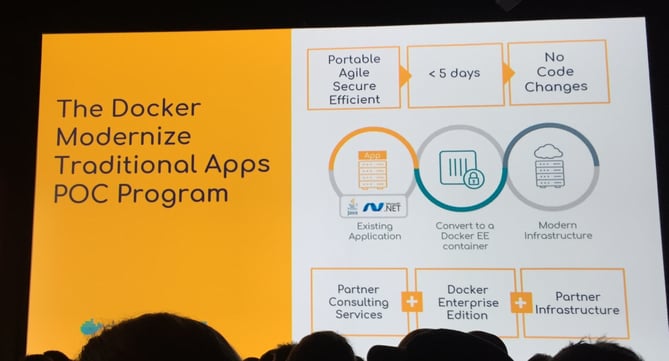
Then Scott explained the MTA POC impact, in term of:
PORTABILITY: customers are hybrid cloud-ready. They are now able to modernized traditional apps.
AGILITY: customers have doubled the frequency through wich they release software
SECURITY: Isolation and integrity
Final Result: reducing total costs by 50%.
He then went in depth with the Modernization Journey, that is structured in the following way:
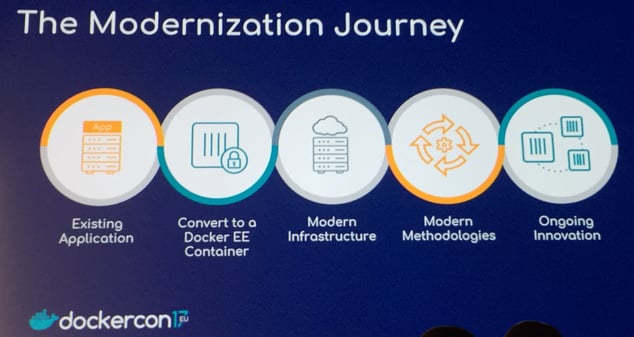
He mentioned that this approach is causing revolutionary results. Other approaches cause low value for customers and a lot of time and effort invested.
Docker MTA bring instead to incremental Value that correspond to the time and effort invested.
IAN GREY (SVP DOCKER) analyzed then the results of the Docker MTA project, that, as said are incremental, non-disruptive, run by customer-driven innovation.
In Companies, the process goes in particular like this:
- It starts with the POC.
- Then there is the First App in production
- It starts the production at scale
- Innovation at your pace.
Going in detail of each step:
1. POC: They define the success criteria for the POC. They containerize, deploy and measure results (this process should last more or less 5 days). This is a model that states the benefits of the customers and the needs.
2. First app in production: that starts from the Application Modernization Workstream, done for every application. The Foundations of this Modernization are the Toolchain, the platform and the governance.
3. Production at scale Innovate at your Pace
There was then a Customer Example by Finnish Rail & Accenture. They explained how Finnish Rail, a big company that creates tracks and transportation, modernized traditional Applications with Docker Enterprise Edition. The drivers for innovation were:
- Cost
- Slow Time to market
- Quality = they wanted to automate
They started from here and created a business case Fit for the Board Room that would have bring to 50% of savings.
They implemented an Accenture Container Migration Factory powered by Docker Enterprise Edition. Drivers of the change:
- Cost efficiency
- Skills
- Reduced risk
- Repeatability
The great results of the case study have been an average of Costs Savings of more than 50% across all apps and can be resumed here: 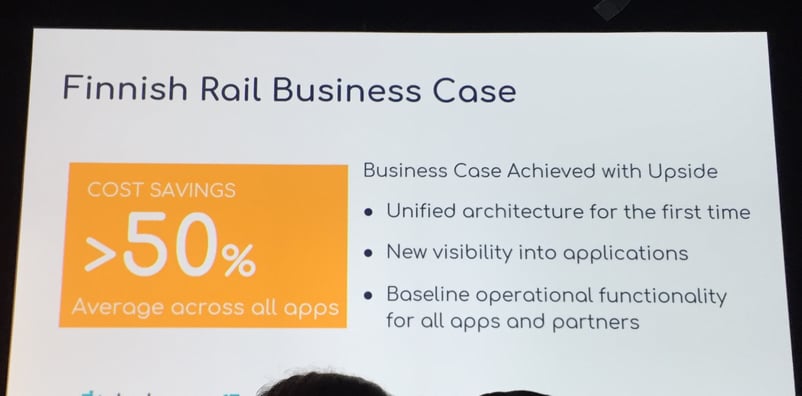
After this Docker Announced the New MTA Program Partner: IBM.
They explained that IBM and Docker partnership is based on relationship. Now the strength is the Combination of Docker with IBM Cloud, and IBM and Docker have a common Modernization Checklist:
- The support for existing software platforms
- A modern cloud platform to move to
- People support.
They showed that some IBM Software are now in the Docker Store, and they announced Docker for IBM Cloud, all followed by a Demo.
Hope you enjoyed all the news as we did during the Conf ;)
Hygge from Copenhagen!





